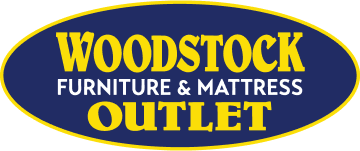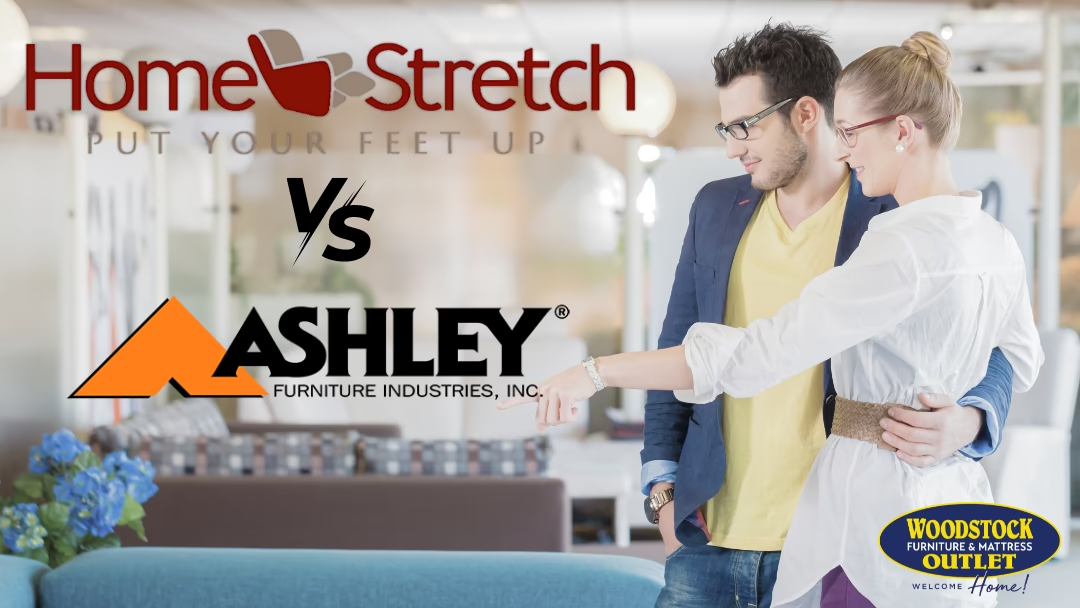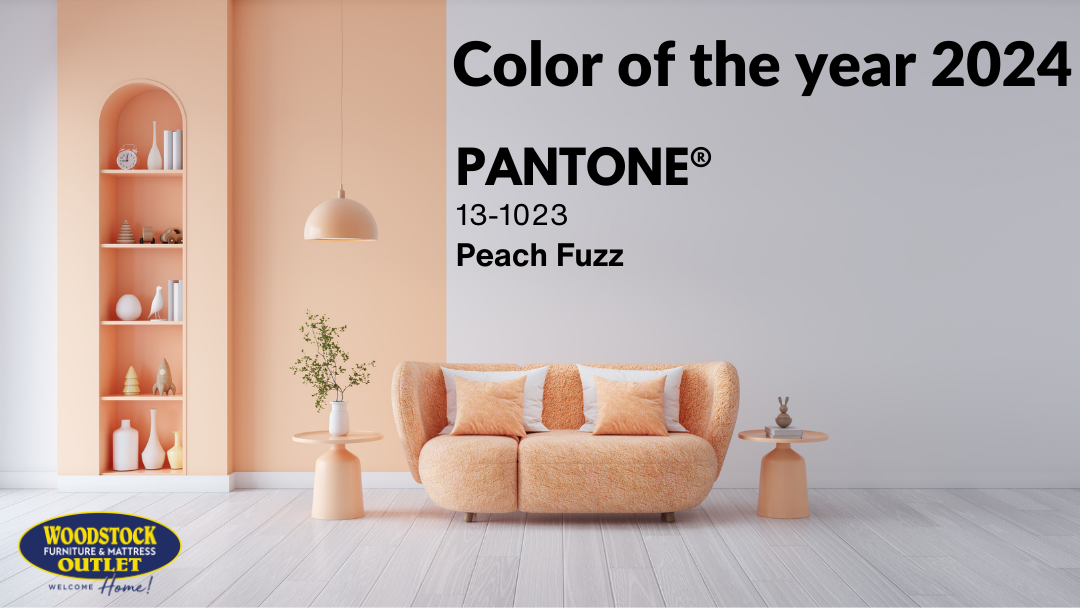Just a few decades ago in the not-too-distant past, buying a mattress seemed like a much simpler task. You’d go to your local mattress store, look at their limited selection, lay on a couple mattresses, and make your choice. And that was about it. There weren’t a whole lot of types of mattresses.
Maybe they had a couple brands, but with rare exception, almost every one of those mattresses were built with spring coils, some batting or cushion, and a quilted cover. At most, you’d find an innerspring mattress with a foam top layer in the form of a Euro top or pillow top.
But the mattress industry has changed a great deal since then. These days, there are so many different mattress options, it can be overwhelming to know where to start.
Here at Woodstock Furniture & Mattress Outlet, curious shoppers often ask about different types of mattresses and how mattresses are made. But what they really want to know are the differences between innerspring, foam and hybrid mattresses. So today, we’re answering as many of these questions as we can!
By the end of today’s article, you’ll know the features that make a mattress an innerspring, hybrid or foam design, as well as the pros and cons of each mattress type. Then you’ll be even more prepared to make an informed mattress shopping decision going forward.
Innerspring vs Hybrid vs Foam Mattress Construction
There are 3 key types of mattresses — innerspring, hybrid, and foam:
Many mattress shoppers are most familiar with innerspring mattresses. As the oldest and most established of these mattress types, most of us grew up sleeping on a traditional innerspring mattress.
After Tempur-Pedic first unveiled their adaptive foam mattresses in the 1990s, the idea of various types of foam mattresses began to gain traction with shoppers. As a result, there was a rapid shift in how mattresses were made.
Finally, around a decade ago, companies began crafting hybrid mattresses in an effort to make a compromise between the qualities of innerspring and foam.
For many customers, they’ve yet to branch out beyond the traditional innerspring designs that they’ve slept on for years – and that’s okay! For others, maybe they’ve spent the last couple decades on a foam mattress and aren’t really sold on the need for hybrid options.
That’s why we’re proud to sell premium quality innerspring mattresses from award-winning brands like Stearns & Foster alongside our top-quality foam and hybrid options from brands like Tempur-Pedic, Purple, Nectar, DreamCloud and Sealy.
However, to truly find the mattress that’s the best fit for you, it’s best to understand all of your options. That’s what we’re doing here today!
The 3 Key Types of Mattresses
Understanding how mattresses are constructed is extremely important for those hunting for the perfect mattress.
Of course, not all mattresses fit neatly into these 3 categories – take Purple and its patented Purple Grid for instance. Even most traditional innerspring designs have some sort of quilted top foam these days. As a result, we feel the need to clarify what we mean with each of these mattress types.
Each of these categories are defined solely by their base layer of support. For example, an innerspring mattress’ lowest base layer consists of metal springs or coils. Meanwhile, foam mattresses sit on a dense base foam, and hybrid mattresses sit on a combined base of foam and pocketed coils.
Once again, not all mattresses fit neatly into these categories. While Tempur-Pedic’s adaptive technology isn’t memory foam, it is still foam. Similarly, Purple’s Gel-Flex Grid is a hyper-elastic polymer, so definitely not foam. However, the original Purple mattress and Purple Plus do sit on a dense base foam. So for our purposes here today, we categorize these exceptions as foam mattresses.
Innerspring Mattresses
A typical innerspring mattress consists of relatively few layers. Most often, there’s a layer of spring coils, with foam quilted into the top layer, although there can be extra layers as well. Euro tops and pillow tops are a good example of this as they both add an additional layer of top foam.

Innerspring mattresses typically have the most responsive feel and the strongest edge support. As you lie on an innerspring mattress, the spring coils actually push back against you. This gives the mattress that bounce.
Those same springs are also what give innerspring mattresses the best edge support, meaning you won’t feel the mattress sink or fold if you get too close to the edge of the bed. Together, these features make it easier to change sleeping positions and get in and out of bed with an innerspring mattress.
These same features come with a couple drawbacks though. The trade-off with the innerspring’s high responsiveness is that often motion can transfer too easily to your partner, disturbing their sleep. Additionally, innerspring mattresses aren’t usually the best for contouring to the curves of your body. So they tend to offer less pressure relief than other types of mattresses.
Pros:
- More responsive (“bounce-back” from mattress)
- Stronger edge-support (mattress won’t sink/fold when you’re close to the edge)
Cons:
- Less motion isolation (movement in bed can disturb partner)
- Less pressure relief (less contouring of the body and relief of pressure points)
Foam Mattresses
Although they’ve been around for a few decades now, foam mattresses are increasingly popular these days. With the rise of the mattress-in-a-box market and brands like Nectar, foam mattress designs have become more affordable and accessible than ever before. While not all foam mattresses are created equal, foam mattress construction is typically the most straightforward.

Most foam mattresses have multiple layers of foam, increasing in density, from top to bottom. At bare minimum, this usually includes at least three layers – a top foam, core foam, and base foam.
For the relief of pressure points (where your weight is most densely distributed on the mattress, like your hips, shoulders, upper back, etc.), it doesn’t get any better than the contouring comfort of a foam mattress. Foam mattresses also generally offer the best motion isolation, which can be useful if you sleep alongside a light sleeper.
On the downside, foam is also the least responsive. If you struggle getting in and out of bed or have limited mobility, foam mattresses may make you feel like you’re sinking too far into the mattress. Foam mattresses also typically offer less edge support than other mattress types.
*In the past, a common complaint was that foam mattresses would retain too much heat and make sleepers hot and miserable. However, in our experience, nearly all foam mattress makers these days have addressed this issue by adding cooling gel layers, moisture-wicking covers, better ventilation, etc. So this isn’t much of an issue anymore.
Pros:
- Better pressure relief (mattress cradles/contours the body to relieve pressure points)
- Superior motion isolation (movement in bed won’t disturb partner)
Cons:
- Less responsive (may be harder to change position, get in/out of bed, etc. for those with limited mobility)
- Less edge support (mattress may sink/fold when close to edge of the bed)
Hybrid Mattresses
Hybrid mattresses are the new kid on the block. With this mattress type, there are usually pocketed coils sandwiched between a dense base foam and a comfy top foam. Unlike the coils found in an innerspring mattress, these pocketed coils (also sometimes called encased coils or wrapped coils) are individually-wrapped in fabric and not connected to one another.

Most hybrid designs try to smooth out the various pros and cons of foam mattresses and innerspring mattresses. As a result, they usually offer a good compromise between the pros and cons of each. The highs may not be as high – but the lows aren’t as low either.
Thanks to their extra foam layers, hybrid mattresses generally offer better motion isolation and pressure relief than innerspring designs. And thanks to their pocketed coils, they are generally more responsive and have better edge support than foam mattresses.
Pros:
- Better pressure relief and motion isolation than innerspring (contours body, relieves pressure points, and movement less likely to disturb partner than innerspring)
- Much more responsive than foam designs (has much more bounce than foam)
Cons:
- Less motion isolation than foam (movement more likely to disturb partner than foam)
- Less responsive than innerspring (not as much bounce as innerspring)
Ready to Take the Next Step? Read Our Free Mattress Buying Guide for Everything Else You Need to Know!
Now that you’ve got the details on the different types of mattresses and how they’re made, you’re that much closer to making an informed decision on your next mattress purchase. If you think you’ve got all the info you need, please visit us at any of our 6 North Georgia furniture and mattress stores. Our mattress experts would love to help you sleep better today!
For even more tips on how to find the perfect mattress for you, be sure to check out Woodstock Furniture & Mattress Outlet’s free mattress buying guide!









